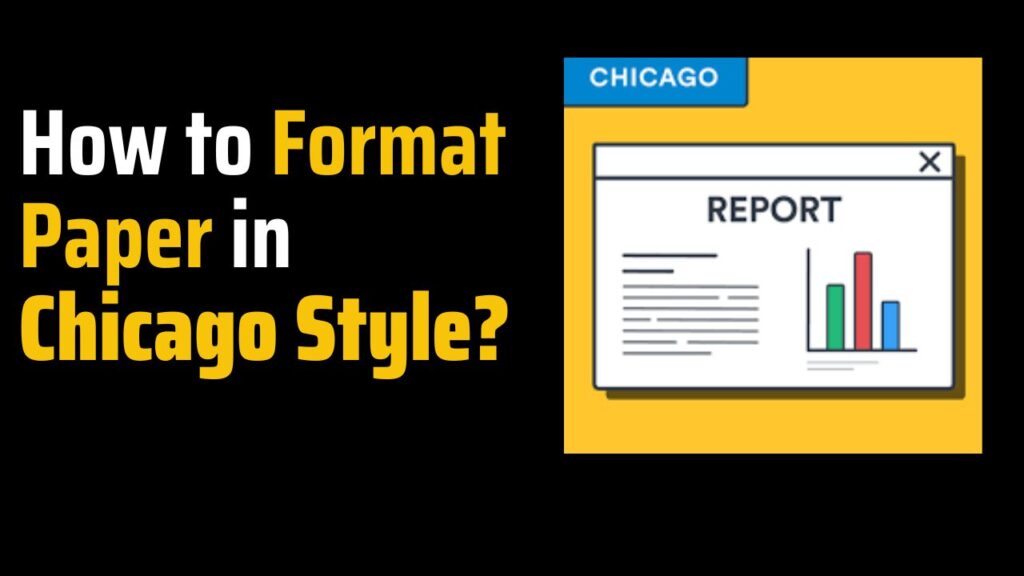When it comes to academic writing and research papers, proper citation and formatting are essential. One widely used citation style is the Chicago Manual of Style (CMS).
Developed by the University of Chicago Press, the CMS provides guidelines for writers in various disciplines.
In this article, we will explore how to format your paper in Chicago Style format, as well as offer tips to avoid common mistakes.
Chicago Style
The Chicago Style format follows a note and bibliography system, also known as humanities style. It is commonly used in literature, history, arts, and other humanities disciplines.
The CMS offers two types of citations: footnotes or endnotes and a bibliography.
- Footnotes or endnotes
- Bibliography
•Footnotes or Endnotes
Footnotes or endnotes are used for in-text citations and provide additional information or commentary on a specific point.
They are indicated by superscript numbers within the text, which correspond to the full citation at the bottom of the page (footnotes) or at the end of the document (endnotes).
•Bibliography
The bibliography is a separate section at the end of the paper that lists all the sources cited in the footnotes or endnotes.
It follows specific formatting rules and provides detailed information about each source, allowing readers to locate and verify the references.
How To apply Chicago format?
- Use a standard font like 12 pt. Times New Roman.
- Double-space the text.
- Use 1 inch margins or larger.
- Indent new paragraphs by ½ inch.
- Page numbers should be placed in the bottom center or top right.
Note that these rules don’t apply if your teacher or professor gives you any formatting advice.
Chicago Style Requirements
To correctly format your paper in Chicago Style, consider the following requirements:
1. Page Setup
- Use standard letter-sized paper (8.5″ x 11″).
- Set 1-inch margins on all sides.
- Use a readable font like Times New Roman or Arial, with a font size of 12 points.
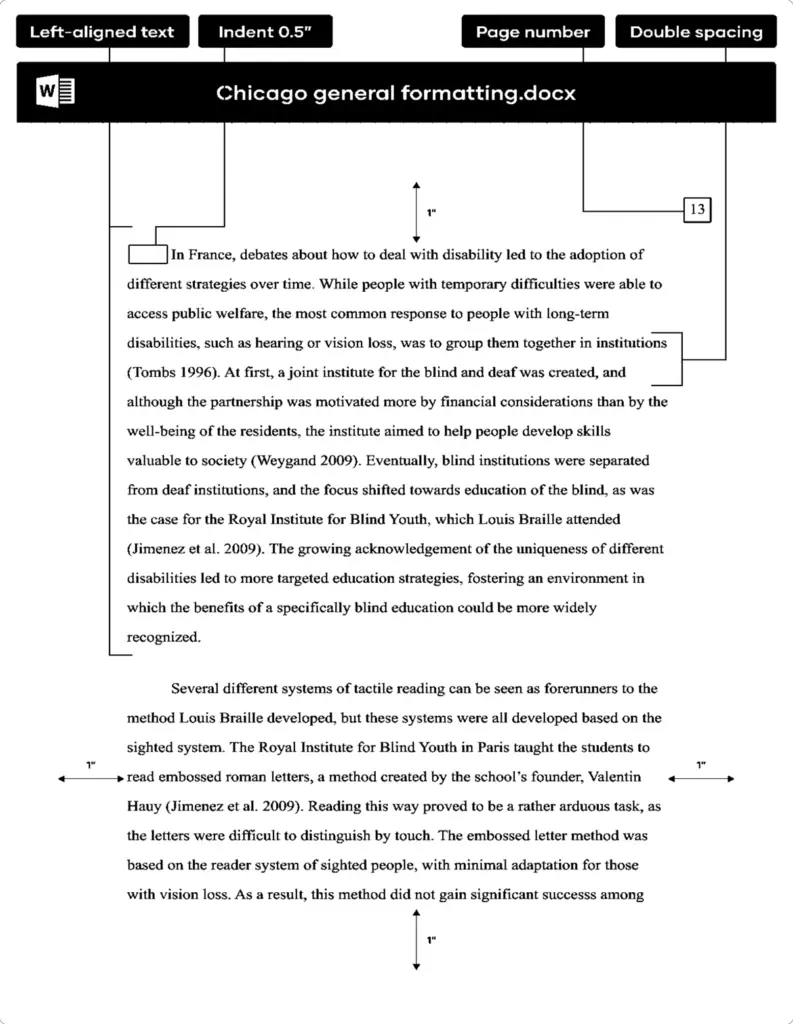
2. Title Page
- Include a title page with the title of your paper, your name, course information, and the date.
- The title page should include all of your text double-spaced, center-aligned, and using the same font as the rest of your text. About a ⅔ of the way down the page, the title should be bold and capitalized in the headline.
- Center-align the title and use headline-style capitalization.
- If there is a subtitle, the main title is followed by a colon, the subtitle is bold, and it is the same size as the main title.
- Page numbering should begin on page 2, hence the title page should be counted among the pages even though it shouldn’t contain a page number.
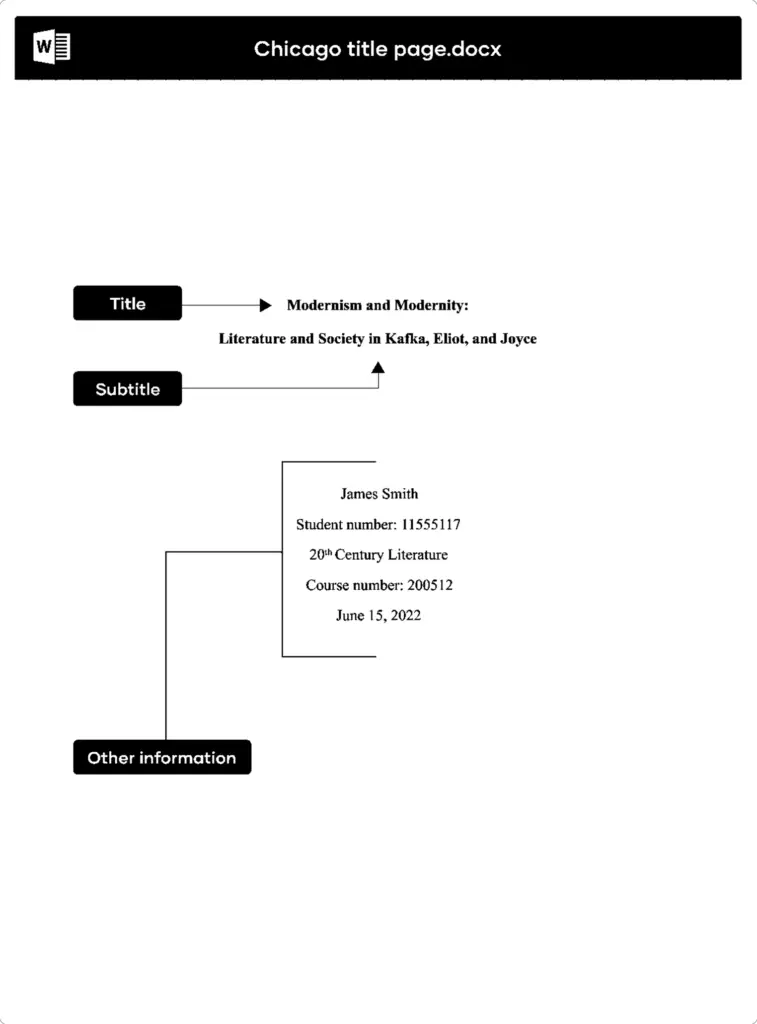
3. Headings
- Headlines should always be capitalized.
- Make sure your presentation makes it clear which form of heading each one is if you use different heading levels (such as chapters, sections, and subheadings).
- Higher-level headings should stand out more from the text than lower-level headings, and all headings at the same level should be presented uniformly.
- You might, for instance, use bold for section headings, a larger font for chapter headings, and italics for subheadings:
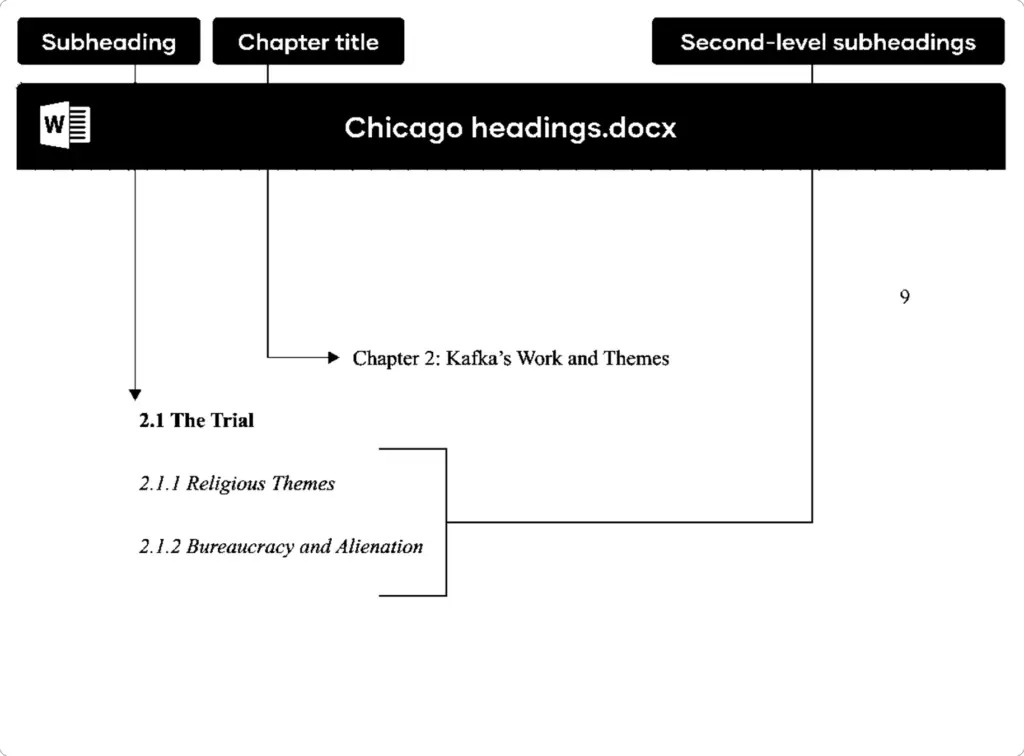
4. Acronyms and numbers
Chicago recommends writing numbers less than 100 in words rather than numbers. For instance, you could write “95” rather than “95.” However, you should continue to use numerals when referring to precise measurements (for example, “15 cm”) and when using decimals (for example, “1.5”).
When using an acronym for the first time, it should be refered what it stands for:
After this, you can just use the acronym.
The Arithmetic and Logic Unit (ALU) is used for …
The start of a phrase shouldn’t contain either digits or acronyms. Write down the whole phrase or number, or rewrite the sentence such that the number or acronym appears elsewhere:
❌500 people responded to the survey.
✔Five hundred people responded to the survey.
✔The survey received 500 responses.
5. Text Formatting
- Double-space your entire paper, including the footnotes, endnotes, and bibliography.
- Use left-aligned text and leave a single space after periods or other punctuation marks.
6. Footnotes or Endnotes
Chicago gives requirements for two citation styles: author-date and notes and bibliography.
author-date style
Citations are included directly in the text in parentheses in author-date style. You have some options in this format regarding how to incorporate the citation precisely:
- Place superscript numbers after the punctuation marks in the main text.
- Start the corresponding note with the same superscript number, followed by the citation details.
Davis (2016) argues that the theory is “sound.” However, contrary findings have been made by other researchers (Lee et al. 2017, Johnson 2018).
bibliography style
Citations in notes and bibliography style are identified in the text by superscript numbers and appear as Chicago footnotes or endnotes (the format is the same in both cases).
- Numbers for the footnotes and endnotes are placed at the end of the relevant clause or sentence, following all punctuation except dashes.
- Footnotes are located at the bottom of each page, whereas endnotes are located on their own page just before the bibliography.
- Footnotes should be provided in the same font size as the main text, or lower, and separated from it by a short rule. The footnote feature in Word generates footnotes automatically like this:
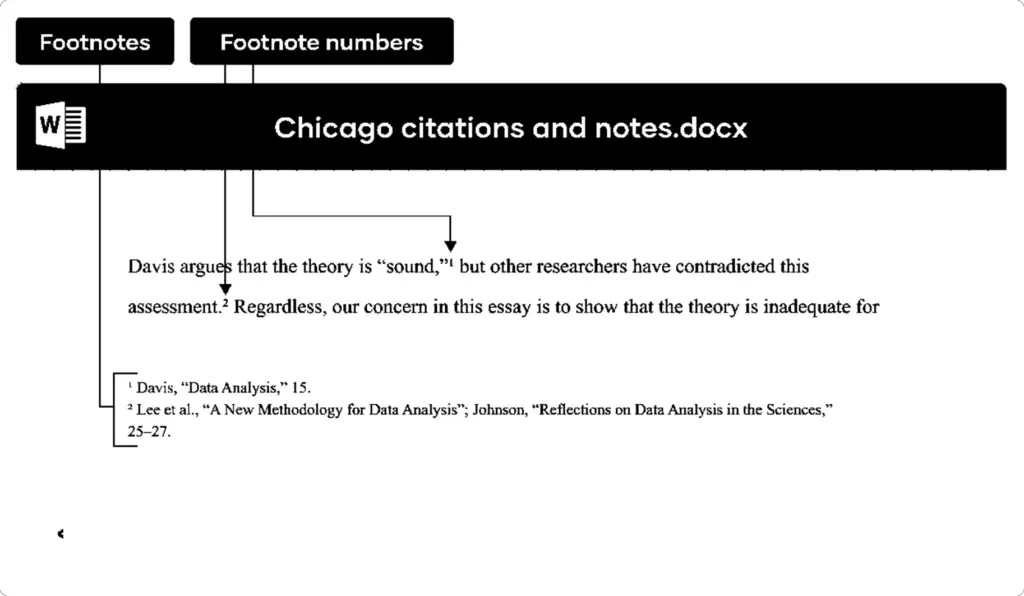
5. Bibliography
- Arrange the bibliography in alphabetical order by the author’s last name.
- Use hanging indentation, where the first line of each entry is flush left, and subsequent lines are indented.
- You’ll most likely include a bibliography (for notes and bibliography style) or a reference list (for author-date) at the end of your paper.
- A blank line should be left between each entry in bibliographies and reference lists rather than using double spacing.
- If an entry goes beyond the first line, all lines after the first should be indented by ½ inch.
- The format for a annotated bibliography should be used if you have to create a Chicago style annotated bibliography, however you should indent and double-space the annotations under each source reference.
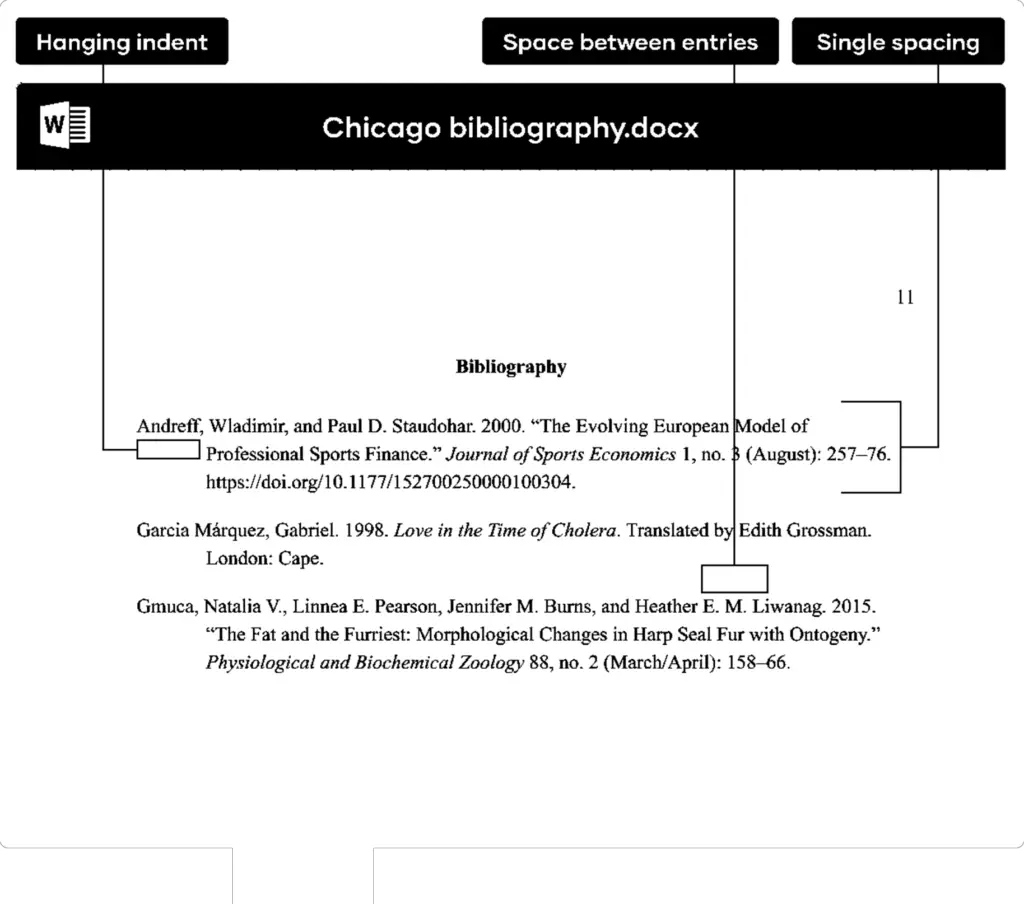
Examples of Chicago Style Citations
To better understand the Chicago Style format, let’s look at some examples:
▶Book Citation
Footnote/Endnote
1.David McCullough, The Wright Brothers (New York: Simon & Schuster, 2015), 45.
Bibliography
McCullough, David. The Wright Brothers. New York: Simon & Schuster, 2015.
▶Journal Article Citation
Footnote/Endnote
2. Richard N. L. Andrews, “The Influence of Architecture in Gothic Literature,” Journal of Gothic Studies 10, no. 2 (2018): 78-92.
Bibliography
Andrews, Richard N. L. “The Influence of Architecture in Gothic Literature.” Journal of Gothic Studies 10, no. 2 (2018): 78-92.
Certainly! Here’s an alternative example for a website citation in Chicago Style:
▶Website Citation
Footnote/Endnote
3. World Health Organization, “COVID-19: Guidance for Schools” (accessed June 20, 2023), https://www.who.int/covid19/schools.
Bibliography
World Health Organization. “COVID-19: Guidance for Schools.” Accessed June 20, 2023. https://www.who.int/covid19/schools.
Where Is Chicago Style Used?
Many subjects continue to use Chicago style. This is still common in the social sciences, but it can be seen in the natural and physical sciences from time to time.
Literature, history, and the arts are the most frequent subjects that still follow to Chicago style. Even though you might not use Chicago style very frequently, knowing how to do so if instructed is helpful.
Knowledge of Author-Date and Bibliography Styles
There are two basic styles to follow if you have been instructed to follow Chicago style. The author-date style is the first, while the bibliography style is the second.
When working with social sciences and natural sciences, the author-date system is widely used. You will use in-text citations in this system. Parentheses should be used to indicate the author’s last name and the year of the publication.
Unlike other citation styles, the author’s name should be included in parentheses. The notes and bibliography system is the name of the other section of the style guide.
This is mostly included if you work in history, literature, or the arts. In the hard sciences or social sciences, you won’t encounter it as frequently. The sources in this citation style are formatted as endnotes or footnotes. They are then given numbers.
Each number should correspond to the appropriate superscript in the text. Additionally, the sources are intended to be added to a bibliographical database. This implies that you will have footnotes at the bottom of each page in addition as a reference list at the end.
Chicago Style: Tips to Avoid Mistakes
When it comes to following the Chicago Style, it’s understandable to feel confused or make mistakes, even if you have the 17th edition of the University of Chicago Style Guide.
However, by keeping a few helpful tips in mind, you can avoid common errors. Here are some crucial points to remember when adhering to Chicago Style:
- Double-spacing: Ensure that all text in your assignment, including block quotations, is double-spaced. This formatting rule promotes readability and consistency throughout your paper.
- Block quotations: When including a block quote, do not use quotation marks. Instead, start the block quotation on a new line and indent it to set it apart from the main text.
- Subheadings: For longer papers, consider using subheadings to organize your content. Use your judgment to determine when a paper qualifies as “long” and requires subheadings for improved structure.
- Page numbers: Place page numbers starting from the first header that appears in your assignment. Use Arabic numerals (e.g., 1, 2, 3) rather than Roman numerals (e.g., I, II, III) for consistency.
- Margins: Ensure that your margins are set to a minimum of one inch on all sides. This allows for proper spacing and readability of your content.
- Font size: Select a readable font, such as Times New Roman, and choose a font size of either 10 or 12 points. This ensures clarity and legibility of your text.
By following these tips, you can navigate the Chicago Style with greater confidence and accuracy. Remember to consult the appropriate style guide for specific guidelines and always proofread your work to catch any remaining errors.
Conclusion
Mastering the Chicago Style format is essential for researchers in humanities disciplines. By understanding the requirements, referring to examples, and adhering to the guidelines, you can confidently format your papers and provide accurate citations.
Remember to stay consistent, proofread diligently, and seek assistance when necessary.
Following these practices will help you navigate the Chicago Style format effectively and showcase your research professionally.



